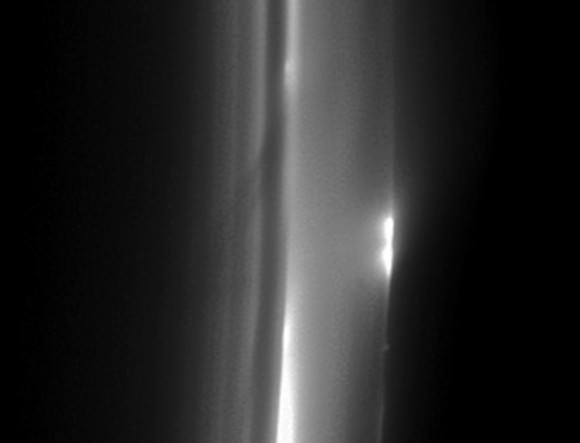Bright clumps of material spotted within Saturn’s ropy F ring (NASA/JPL/SSI)
Released today, this image acquired by NASA’s Cassini spacecraft shows some interesting structures forming within Saturn’s thinnest but most dynamic ring.
Of Saturn’s countless ring structures the F ring may very well be the most dynamic, if not the most fascinating. Orbiting Saturn just outside the edge of the A ring at a distance of 140,000 km (87,000 miles), the F ring is a hazy, ropy band of fine ice particles that shift, twist and occasionally gather into bright clumps… only to drift apart once more.
The F ring can range in width from 30 to 500 km (20-500 miles), depending on what’s going on in and outside of it.
The image above, originally captured by Cassini on June 28 and released today by the Cassini Imaging Central Laboratory for Operations (CICLOPS), shows a particularly bright clump of material at the outer edge of the F ring, as well as some finer structures and streamers forming within the inner bands. Due to the lighting geometry its thought that the clumps are mostly composed of dusty material.
Detail of the ghostly F ring structures (NASA/JPL/SSI)
The features seen here are likely due to the ring’s interactions with passing shepherd moons — such as the 148-km-wide Prometheus — or with small moonlets embedded within the ring itself. Mostly made of fine particles of dust and ice smaller than those found in smoke, the material orbiting within the F ring is extremely susceptible to external gravitational influences.
Original image scale is 4 km (3 miles) per pixel.
See more images from the entire Cassini mission on the CICLOPS site here (and for a look at more interesting ring dynamics check out these recent Cassini images of my personal favorite moon, Daphnis.)



The “F” ring is so cool